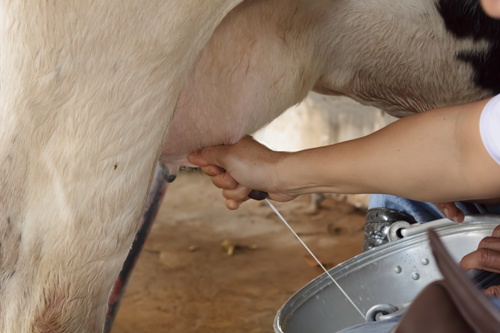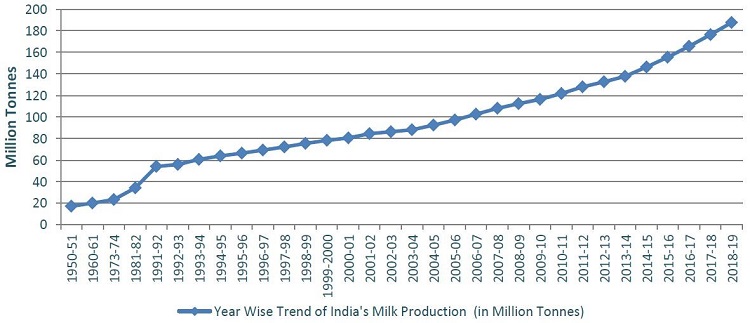Abstract
India is a developing country with the world’s most milk production capacity. Strategic interventions in the Indian dairy industry over the years made the country the best of its kind. Major changes in the system happened as a result of the program named ‘operation flood’. The cooperative dairy system changed the countries dairy sector and gave confidence to each dairy farmer of the country. Improvisations in the genetic score, nutritional status, marketing, husbandry, animal health, and farmer security helped the country to achieve its best result. The Indian model of dairy development program can be replicated in developing countries for the improvisation of the dairy sector.

Introduction
India ranks first among the world’s milk-producing countries since 1998 and has the largest bovine population in the world. Milk production in India during the period 1950-51 to 2018-19, has increased from 17 million tonnes (MT) to 187.75 MT. The per capita availability of milk in India which was 130 grams per day during 1950-51 has increased to 394 grams per day in 2018-19 as against the world estimated average consumption of 294 grams per day during 2017 [1]. This represents sustained growth in the availability of milk and milk products for a growing population.
Indian dairy sector has undergone numerous changes after getting independence from British rule. It faced the world’s largest dairy development program- The White Revolution. Later on, strategic interventions for the betterment of dairy farming made the country to world’s highest milk producer.
Indian dairy industry: Struggle and achievements
Approximately 150 million households around the globe are engaged in milk production. In most developing countries, milk is produced by smallholders, and milk production contributes to household livelihoods, food security, and nutrition. Milk provides relatively quick returns for small-scale producers and is an important source of cash income. In the last three decades, world milk production has increased by more than 58%, from 522 million tonnes in 1987 to 828 million tonnes in 2017. India is the world’s largest milk producer, with 21% of global production, followed by the United States of America, China, Pakistan, and Brazil [2]. Since the 1970s, most of the expansion in milk production has been in South Asia, which is the main driver of milk production growth in the developing world.
Dairying has become an important secondary source of income for millions of rural families and has assumed the most important role in providing employment and income-generating opportunities, particularly for marginal and women farmers [3]. Most of the milk is produced by animals reared by small, marginal farmers and landless laborers.
Buffalos are one of the major strengths of the Indian dairy sector [4]. Nearly 55% of milk produced in-country is originating from buffalo, and it has got higher fat content, which fetches higher prices at the market since the milk prices are determined by volume, fat, and solids-not-fat (SNF) content [1]. Certain products like Buffalo Mozzarella Cheese, Buffalo Ghee, etc. can command a huge premium in markets like the United States and Europe and are also preferred by Dairy farmers due to high returns [5].


Interventions that leads the Indian dairy sector to the world’s height
The Green Revolution initiated in the late 1960s and early 1970s ensured food security for India and the White Revolution initiated during the same period ensured self-sufficiency in milk while many other developing countries continue to depend on the import of milk products even today. India started its cooperative milking society system under the leadership of Dr. Verghese Kurien, Tribuvandas Patel, H.M.Dalaya, who was known as the trios behind the success of ‘Amul’- India’s first dairy cooperative society [6]. ‘Anand pattern’ Dairy cooperative system was disseminated across the country through the creation of the National Dairy Development Board (NDDB) in 1965. ‘Operation Flood’ helped the Indian dairy sector to create a National Milk Grid, through which milk reached consumers across 700 cities and towns of the country. The cooperative system eliminated the need for middlemen and thereby reduced the seasonal price variation. The complete power of controlling the dairying industry was transferred to farmers and it made a huge change in farmer’s profit [7].
Several schemes and programs implemented by the government helped the dairy sector to grow quickly. Salient features of the improvement are described below,
Genetic improvement of dairy animals
Though India has the world’s highest cattle population, per animal production is very low compared to developed countries. Genetic improvement of indigenous animals improved in milk production through countrywide efforts. Artificial insemination programs were implemented at the doorstep of farmers, a selective breeding program was implemented to target the genetic improvement of high producing animals. A Cross-breeding program was introduced to improve the genetic potential of desi cows. Certain breeds are selected for ‘grading up’ the indigenous buffalo and cattle through successive generations. Advanced technologies like multiple ovulation and embryo transfer technology (MOET), in vitro fertilization and cloning, sexed semen technology, marker-assisted selection (MAS) was introduced later to achieve new heights [8].
Interventions in Nutrition and feed management
Being a critical component that determines the productivity of animals, nutritional improvisation is an essential arena for achieving good production. Introduction of bypass protein, fat, probiotics, prebiotics, synbiotics, chelated minerals, urea molasses multi-nutrient blocks (UMMB), protected amino acids, etc. to dairy animal feeding made good results in productivity [9,10]. Also, technologies like silage making technology, total mixed ration introduced to farmers. The intervention of National Feeding Standards according to the requirement of indigenous and crossbred milch animals helped the country to achieve the proper nutrient requirements of animals.
Innovations in Farm Management
As technological innovations adapted in dairying, farmers got several advanced facilities that provide less manual work and labor cost. Modern milking machines are introduced into the Indian scenario long back. Farmers adopted various kinds of milking facilities suitable for milking cows, buffalos. Milking parlor-type facilities are adapted by high-producing farms [11].
E-Commerce space in the dairy sector
Introduction of e-Commerce in marketing has changed the phase of the current business sector. In the dairy sector government of India introduced a portal named e-pashuhaat, where the facility for purchasing and marketing high producing animals, embryos, semen are available [12].
Government policies
Indian government took efforts to protect dairy farmers from the exploitation of middlemen and private sector dairy businesses. The government banned the import of cheap dairy products from other countries, like Australia and New Zealand, where the milk production is surplus.
Modern technologies for dairy farming
Newer technologies can add further benefits to the current dairying industry. Blockchain technology can be used for tracking the genomic profile of dairy animals, disease history, milk production statistics, processing history of dairy products, etc [13, 14]. Precision farming is another technology where novel technologies like health tracking gadgets, RFID technology, Mastitis detection tool, farm management software can be used. Genome editing for exploiting high production can be achieved by CRISPR gene-editing tools [15].
The way forward
Milk is one of the essential food commodities for Indian people. It provides a source of protein, energy, fatty acids, minerals, and vitamin. The dairy industry has grown to the world’s first by wise application of strategies in previous decades. But, still, some drawbacks are dragging the Indian dairy sector back. Identifying these drawbacks and applying corrective measures should be the prime mandate for the growth of the sector.
Like in the agriculture sector, the government can implement MSP (Minimum Standard Price) for dairy products, so that farmers can assure a minimum cost for their effort. It can protect them from unexpected losses. Currently, India following a biaxial pricing system, based on fat% and solid not fat (SNF) content. Restructuring of the system is the need of the time as several other countries are not following the same. Complete exploration of indigenous cattle genome has not yet been carried out. It should be carried out for identifying genes of production and should be exploited accordingly. Also, besides conventional milch animals, unconventional milk sources should be promoted like goat, sheep, camel, and donkey milk.
Conclusion
Indian dairy sector can be taken as a model for developing countries for planning and developing their dairy sector as it has undergone a huge positive change with time. Efforts of farmers with good leaders made the Indian dairy industry to the world’s height. Though remaining the world’s number one since 1998, improvisation is needed in many parts of the Indian dairy industry to grow further.
References
- BAH & FS. 2019. Basic Animal Husbandry and Fisheries Statistics, (2019). Department of Animal Husbandry, Dairying and Fisheries. Ministry of Agriculture and Farmers Welfare, Government of India.
- World Bank. (2011). Module 4- Smallholder dairy production. Agriculture Investment Sourcebook, April 2013 (available at: http://go.worldbank.org/LE880YAAH0).
- Jaiswal, P., Chandravanshi, H., & Netam, A. (2018). Contribution of dairy farming in employment and household nutrition in India. j. avian wildl. 3(1).
- Hoffpauir, R. (1982). The water buffalo: India’s other bovine. Anthropos, 215-238.
- Jayadevan, G. R. (2013). A strategic analysis of cheese and cheese products market in India. Indian J Res.2(3): 247-250.
- Bellur, V. V., Singh, S. P., Chaganti, R., & Chaganti, R. (1990). The white revolution—How Amul brought milk to India. Long Range Planning, 23(6): 71-79.
- Cunningham, K. (2009). Rural and urban linkages: Operation flood s role in India s dairy development(Vol. 924). International Food Policy Research Institute.
- Sreenivas D (2013) Breeding policy strategies for genetic improvement of cattle and buffaloes in India, 6(7): 455-460, doi:10.5455/vetworld.2013.455-460
- Garg, M. R. (1998). Role of bypass protein in feeding ruminants on crop residue based diet-Review. Asian-australas. J. Anim. Sci, 11(2):107-116.
- Patil, A. K., Katole, S., & Agrawal, V. (2017). Urea Molasses Mineral Supplement For Enhancing Livestock Productivity. Vet Res., 5(04):75-79.
- Lallawmkimi, M. C., & Mahendra, S. (2009). Milking behaviour of Murrah buffaloes during hand and machine milking. Indian Vet J, 86(2):171-173.
- Department of Animal Husbandry and Dairying, Government of India. 2020. Schemes and Programs. https://dahd.nic.in/ accessed on 18 November 2020
- Casino, F., Kanakaris, V., Dasaklis, T. K., Moschuris, S., Stachtiaris, S., Pagoni, M., & Rachaniotis, N. P. (2020). Blockchain-based food supply chain traceability: a case study in the dairy sector. Int. J. Prod. Res., 1-13.
- Shingh, S., Kamalvanshi, V., Ghimire, S., & Basyal, S. (2020). Dairy Supply Chain System Based on Blockchain Technology. Asian J Econ Bus Acc., 13-19.
- Menchaca, A., Dos Santos-Neto, P. C., Mulet, A. P., & Crispo, M. (2020). CRISPR in livestock: From editing to printing. Theriogenology, 150, 247–254. https://doi.org/10.1016/j.theriogenology.2020.01.063



Be the first to comment